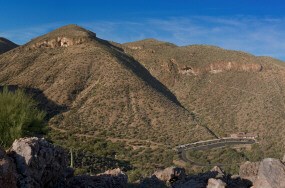New Firearms Law
As of February 22, 2010, a new federal law allows people who can legally possess firearms under applicable federal, state, and local laws, to legally possess firearms in this park. For more information, click on the link.
Archeological Site Etiquette
Arizona contains some of the nation's - and indeed the world's - greatest archaeological sites. Please take a few minutes to familiarize yourself with this site etiquette guide that will facilitate an enjoyable visit for you, AND for others who follow you! This is a PDF document.
Oversized vehicles
Parking lot has limited turning radius; vehicles longer than 30 feet and towing another vehicle experience difficulty negotiating the turn. Large vehicle parking is available 1/2 mile below visitor center at picnic area.
Desert Hazards
Reptiles
There are four venomous snake species at Tonto National Monument: the Western Coral Snake and three species of rattlesnake - Western Diamondback, Arizona Black, and Blacktail. Non-venomous snakes in the area include the Gopher, King, and Whipsnake. Lizard species include Horned Lizards, Banded Geckos, and Gila Monsters - one of only two venomous lizards in the world. Reptiles are often a visitor's main concern in the desert, but most of these animals are rarely seen. If you happen to encounter one, give it the right-of-way.
Spiders and Stinging Insects
For the most part, centipedes, scorpions, and spiders feed at night. If you happen to encounter one, give it the right-of-way.
Honeybees live in the caves and crevices along the trails. Wasps are more commonly encountered in the riparian area of the Upper Cliff Dwelling Trail. If you are allergic to insect stings, plan accordingly. Bees and wasps are attracted to sugar, so it is a good idea to carry water instead of sodas. For more information about dealing with bees, click on the link. This is a Word Document.
Desert Plants
Agave, Teddy Bear Cholla, and Prickly Pear are but a few of the desert's many spiky plants. If a thorn sticks you, wash the wound and apply a bandage. If the spine is still imbedded, remove it with tweezers and cleanse the wound. Because of the chance of infection, it is a good idea to seek medical advice.
Reducing the effects of the Heat
Hiking in the desert can be a wonderful experience if the proper precautions are taken.
* Slow down. Strenuous activities should be rescheduled to cooler parts of the day.
* Light-colored clothing reflects sunlight and helps maintain normal body temperatures.
* Use a sunscreen with at least SPF 15.
* Drink plenty of water even if you don't feel thirsty.
Wildflowers
Many people travel to the desert to view the spring flowers. You can help make everyone's trip more enjoyable by not picking the flowers. If you miss the peak flowering season, take consolation in the fact that you've missed the peak crowds as well. A tranquil walk through the desert will reward you any time of year.

